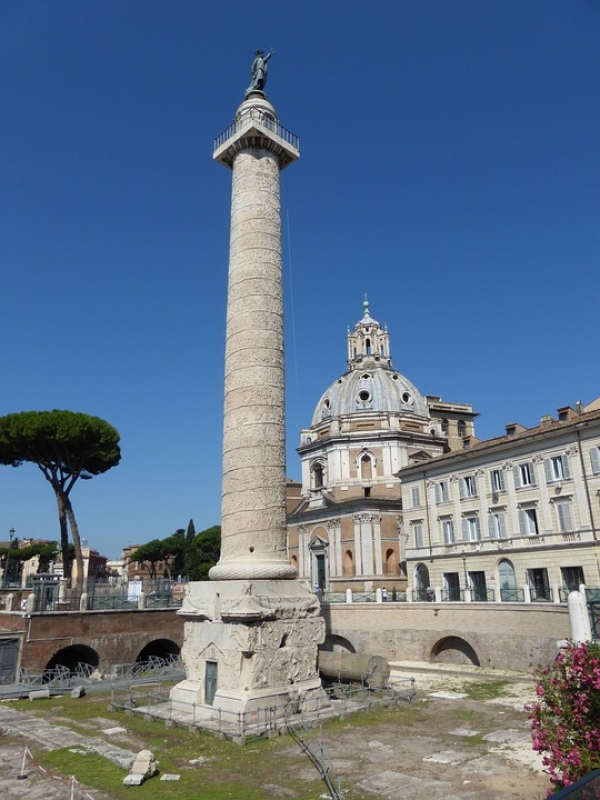When it comes to Roman monuments, you cannot miss the most magnificent ones: the Colosseum, Hadrian’s Tomb (Castel S. Angelo), the ruins
of the Palatine have more majestic measures, imprinting themselves indelibly in everyone’s imagination. But I always take special care in including a monument which, besides being very well preserved, is the quintessence of Roman history: Trajan's Column on Via dei Fori Imperiali (the road from Altare della Patria to the Colosseum).
In the whole Roman world, the Column is the artifact most dense of meanings in relation to the proportions. It has been defined a “movie in stones”, and the invention of a story by frames that climb the spiral will be imitated 16 centuries later in the column of Place Vendome in Paris, intended to narrate Napoleon's victories in the same style.
The column is an urban, architectural, sculptural, historic and memorial manufact. It stood at the center of a vanished context, formed by the Basilica Ulpia, the temple of Trajan, two libraries, for which the saddle that joined the Capitol and the Quirinal hills was excavated. Many emperors loved to join military glory, political commitment and urban architecture. Trajan built towns and ports, raised important monuments, opened the Via, the way bearing his name, from Benevento to Brindisi. In Rome he built a spa complex, the Markets and the Forum, with the column in the center. His successor Hadrian, Emperor architect, was inspired by him: he travelled with armies of skilled workers to leave lasting marks of his journey anywhere, and on the slopes of the Monti Tiburtini he built an extraordinary Citadel improperly defined “villa”, Villa Adriana. It is no coincidence that the Popes, reigning in Rome, followed this tradition; many of them were in fact excellent planners.
Trajan, Spanish by birth, was born in 53 AD and died in 117. Adopted by Nerva, he became emperor in 98. He was loved by the people and even more from the soldiers, who knew his military virtues since he was only a young tribune. The column was erected in 113 to commemorate his victorious wars against the Dacians (101-106). The work rises to about 100 Roman feet (29,78 meters), with a diameter of 3.68 meters, and is formed by 18 overlapping drums on which the marble slabs that make up a frieze are mounted.
The narrative frieze, wound in 23 turns along the stem, to be red from bottom to top and from left to right, such as writing, is about 1 meter high, higher towards the top in order to facilitate reading, for about 200 meters long, and has 2500 figures. Inside the column, a spiral staircase of 185 steps climbs to the summit, where originally the bronze and gold statue of the emperor, 6.20 meters high, stood; there Pope Sixtus V placed the statue of St. Peter in 1587. The base is 7.12 meters high and 6.18 meters wide, with a foundation 21 meters wide and 5 meters deep. Trajan’s ashes were stored inside the burial chamber located under the base, in a golden urn.
Today, going up along the column with your eyes, the deciphering of the marble reliefs becomes practically impossible, if not using powerful binoculars. But originally it was not so, for two reasons: first, the column was painted, as indeed all statues in Rome and Greece, with a very different effect from uniform whiteness that in our imagination corresponds to classicism, and therefore details stood out more for the beautiful colors. In addition, the column was surrounded by tall buildings, whose openings and terraces allowed to look at the friezes at close range.
The intent of the column is clear, also in these days: to celebrate the Roman virtues guaranteeing the solidity of the empire, Trajan’s military prowess and the commanders’ talents. The emperor is depicted in poses and acts representing the cardinal ideas of honor, justice, perseverance and forgiveness. It is in fact the apotheosis of all that legitimized the "Imperium Romanorum", the supremacy of the Romans. In various episodes the Romans appear certain, ordered, calm, magnanimous, compassionate, as the barbarians are furious, confused, anxious. Aside from psychological interpretations, the column is rich in historically objective particulars. First, the descriptive detail of insignia, clothing, weapons and armor would allow us, at a closer look, to recognize one by one the regions and other military formations, regular or auxiliary, which took part in Trajan's campaigns. Second, we could understand the different types of weapons and military tactics of the time. For example, for the first time fully armored knights and horses appear on the column: it’s the Roxolani, allies of the Dacians; their armor was later adopted by Roman special troops and finally over the centuries became the characteristic of the Christian medieval chivalry.
The column shows all Roman troops, with particular emphasis on the two main corpses: Praetorians and Legionnaires. The Praetorians are the Emperor’s bodyguard, 8000 soldiers and 1000 horsemen, well armed and better paid: 1000 “denari” per year, compared to 300 for legionnaires and 100 for auxiliary troops. But the real pillar of the Roman Army is the Legionaire. Until the late imperial age he is always a volunteer and must also be recommended to be enrolled; he must be at least 165 meter tall and march at least 20 km per day, carrying not less than 60 Kg., including the armor, the shield, a bag of flour and also two sharpened stakes to build the fence of the camp. After 25 years of service he gets the leave and liquidation: infact his pay has always been set aside by the Military Treasury, if not for some pennies.
After some time at the basis of the column, even the most uninterested tour mate is wondering: what was the secret of the Roman Army? Well, the Roman army was not only a great war machine, was first of all a formation of very skilled technical specialists, expert in all kinds of working activities, and probably that was its main strength. The Column shows it all: not infrequently legionaries appear intent on building bridges, camps, roads, while auxiliary troops oversee or collide with the enemy. Engineering techniques during the Dacian wars allowed rapid maneuvering and supply, easy access to enemy territory, a system of canals to bypass the rapids, a magnificent bridge on the Danube, a famous road cut in the rocks of Danube Iron Doors. The war took many twists and turns. While the Romans were advancing towards their fortifications, the Dacians with their Roxolani allies successfully launched a persionary attack at another point of the boundary. Trajan's answer was immediate: with an amphibious operation, the soldiers, like modern marines, were loaded on ships to get to the site of the battle as quickly as possible. As seen on the column, Trajan himself was on board one of these boats. Eventually the Dacians asked for a truce, which was granted with a ceremony under the walls of the capital, with the King Decebal prostrate before Trajan enthroned, between rows of legionaries and Praetorians. However, the peace did not last, soon the Dacians resumed guerrilla warfare and a second campaign ended with the final defeat of the Barbarians and the suicide of Decebalus, whose severed head was brought to Trajan on a dish. The region at this point was completely Romanized: Romania was born.
The frames of the frieze narrate these events. The style is realistic, despite some essential stylization, having to concentrate each time in a small space a very complex scene: a tree is a forest, a wall a fortress, one or two galloping horsemen a cavalry charge. The faces of the Roman soldiers and barbarians reveal characters and feelings. Even the excited scenes of action and war show artistic skill and masterly inventiveness.
The column, miraculously intact, is the only source of the story of the wars conducted by Trajan in Dacia. After all, a useless and bloody conquest, pushing the boundaries of the empire months away from the capital and adding nothing to the overflowing Treasury funds. This endeavor is indeed the personal ambition of an emperor soldier, but it show also the inability to stop of the great Roman army machine: perfectly oiled, having won everything there was to win, it was the real engine of the big Roman society, based on the recycling of prey, lands, goods, slaves.
Who, then, was the author of the column? The tradition and the aesthetic and stylistic evaluations indicate Apollodorus of Damascus, the designer of the bridge over the Danube. For his versatility, his culture, his craftsmanship, Apollodorus seems to anticipate the great Renaissance personalities, like Leonardo and Michelangelo. However, his destiny was not happy: the successor of Trajan, Hadrian, had him killed. The Emperor, who considered himself an artist, was humiliated by Apollodorus the first time when he was still alive: while he was illustrating building design to Trajan and his entourage, Hadrian interjected and Apollodorus stopped him: "Do not bother, continue to draw your pumpkins, you do not understand anything about these things." After Trajan died, Apollodorus kept on working for some time, so high were his authority and his skill. But the Emperor did not tolerate criticism to the project of a temple that he himself had designed, with apparently wrong measures in relation to the statues to be placed inside.
We are not sure that Apollodorus was the author of the column. Anyway, what matters is that the column is not only a beautiful work of architecture and sculpture, it is primarily a text that refers to the world in which it was conceived. So whoever was its creator, the author was certainly Rome.

